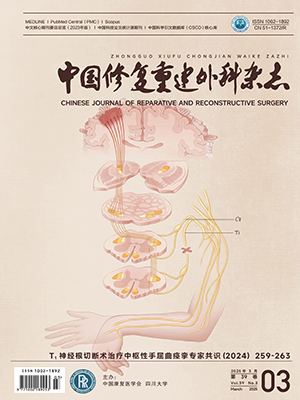| 1. |
陈晓峰, 李晓林. 锁骨远端骨折的治疗进展. 中华创伤骨科杂志, 2012, 14(9):810-813.
|
| 2. |
Robinson CM, Court-Brown CM, McQueen MM, et al. Estimating the risk of nonunion following nonoperative treatment of a clavicular fracture. J Bone Joint Surg (Am), 2004, 86-A(7):1359-1365.
|
| 3. |
Oh JH, Kim SH, Lee JH, et al. Treatment of distal clavicle fracture:a systematic review of treatment modalities in 425 fractures. Arch Orthop Trauma Surg, 2011, 131(4):525-533.
|
| 4. |
蔡晓冰, 张立国, 竺伟, 等. 锁定加压钢板治疗锁骨远端NeerⅡB型骨折. 中华骨科杂志, 2012, 32(7):659-663.
|
| 5. |
Richards RR, An KN, Bigliani LU, et al. A standardized method for the assessment of shoulder function. J Should Elbow Surg, 1994, 3(6):347-352.
|
| 6. |
Nadarajah R, Mahaluximivala J, Amin A, et al. Clavicular hook plate:complications of retaining the implant. Injury, 2005, 36(5):681-683.
|
| 7. |
van der Meijden OA, Gaskill TR, Millett PJ. Treatment of clavicle fractures:current concepts review. J Shoulder Elbow Surg, 2012, 21(3):423-429.
|
| 8. |
Wijdicks FJ, van der Meijden OA, Millett PJ, et al. Systematic review of the complications of plate fixation of clavicle fractures. Arch Orthop Trauma Surg, 2012, 132(5):617-625.
|
| 9. |
Oe K, Gaul L, Hierholzer C, et al. Operative management of periarticular medial clavicle fractures-report of 10 cases. J Trauma, 2011.[Epub ahead of print].
|
| 10. |
Shin SJ, Roh KJ, Kim JO, et al. Treatment of unstable distal clavicle fractures using two suture anchors and suture tension bands. Injury, 2009, 40(12):1308-1312.
|
| 11. |
Kontautas E, Pijadin A, Vilkauskas A, et al. Biomechanical aspects of locking reconstruction plate positioning in osteosynthesis of transverse clavicle fracture. Medicina (Kaunas), 2012, 48(2):80-83.
|
| 12. |
Will R, Englund R, Lubahn J, et al. Locking plates have increased torsional stiffness compared to standard plates in a segmental defect model of clavicle fracture. Arch Orthop Trauma Surg, 2011, 131(6):841-847.
|
| 13. |
Favre P, Kloen P, Helfet DL, et al. Superior versus anteroinferior plating of the clavicle:a finite element study. J Orthop Trauma, 2011, 25(11):661-665.
|
| 14. |
Formaini N, Taylor BC, Backes J, et al. Superior versus anteroinferior plating of clavicle fractures. Orthopedics, 2013, 36(7):898-904.
|
| 15. |
黄俊伍, 罗轶, 张春林, 等. 解剖型钢板与锁骨钩钢板治疗锁骨远端骨折的临床疗效. 中华创伤杂志, 2012, 28(12):1073-1077.
|
| 16. |
Yoo JH, Chang JD, Seo YJ, et al. Stable fixation of distal clavicle fracture with comminuted superiol cortex using oblique T-plate and cerclage wiring. Injury, 2009, 40(4):455-457.
|
| 17. |
Sohn HS, Shin SJ, Kim BY. Minimally invasive plate osteosynthesis using anterior-inferior plating of clavicular midshaft fractures. Arch Orthop Trauma Surg, 2012, 132(2):239-244.
|
| 18. |
Bisbinas I, Mikalef P, Gigis I, et al. Management of distal clavicle fractures. Acta Orthop Belg, 2010, 76(2):145-149.
|




